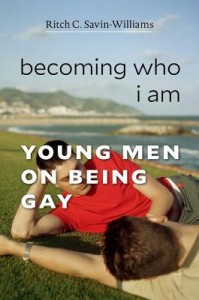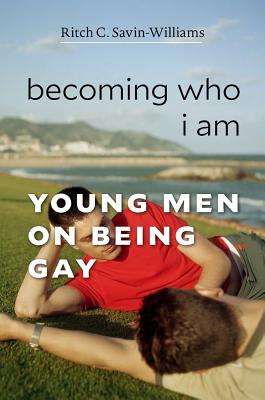 Becoming Who I Am: Young Men on Being Gay
Becoming Who I Am: Young Men on Being Gay
by Ritch C. Savin-Williams
Harvard. 322 pages, $27.95
IMAGINE collecting all your most awkward, embarrassing, and dreamy adolescent moments from your first gay crush, coming out to friends and family, first sexual experience, that dating disaster, the love of your life, and the breakup. Now multiply that by seventeen, and you have a feeling for Ritch Savin-Williams’ Becoming Who I Am.
Savin-Williams is a developmental psychologist and the director of the Sex & Gender Lab at Cornell University, where he has been conducting research on the psychosexual development of gay, lesbian, and bisexual teens for three decades. He has been prodigiously productive in examining sexual developmental milestones, sexual identity labels, and sexual minority psychology throughout the lifespan. He was highlighting sexual and gender fluidity way before “genderqueer” registered on the cultural radar. His work is characterized by an unusual optimism about LGBT teens. While much of the published literature on this group emphasizes high rates of bullying, depression, substance use, HIV risk, marginalization, and suicide, Savin-Williams, in this book and in his The New Gay Teenager (2005), cheerfully exclaims: “The kids are all right!”
The stark difference in these two sets of conclusions, I suspect, reflects significantly different pools of interviewees. A century of forensic and psychoanalytic publications on “sexual perverts” and “homosexuals” firmly established them as profoundly dysfunctional, if not sociopathic. Aside from the bias of the researchers, they were also basing their experience on informants gathered from jails, police stations, mental hospitals, and psychoanalysts’ couches. It was not until a broader population of nonclinical gays and heterosexuals was studied by researchers such as Alfred Kinsey and Evelyn Hooker in the 1940s and ’50s that it became possible to conceive of “normal” homosexuals, as well as publicize the great spectrum of sexuality beyond the “normal.”
The association between homosexuality and psychopathology that had been a tenet of psychoanalytic theory further weakened after the gay rights movement of the 1960s. The Chicago Gay Liberation Front protested at the 1970 convention of the American Medical Association, distributing a leaflet declaring: “Off the couches, into the streets!” Similar activist pressure on the American Psychiatric Association (APA) would lead to the removal of the diagnosis of “Homosexuality” from the APA’s classification of mental disorders in 1973. Overnight, gay people were no longer considered mentally ill. One journalist wryly noted that it was the greatest cure in the history of psychiatry! Many subsequent researchers started to discover that gay people did not have astronomical rates of psychological disorders. Having a new, younger generation of gay researchers probably contributed to this trend, in part because they knew where to find a nonclinical pool of informants.
The pendulum started to swing back again in the early 1980s with the emergence of AIDS, which had the effect of focusing research money and efforts around illness. Of course, understanding the risk factors and the most affected populations was a crucial and hard-fought public health priority. National studies of LGBT development and mental health have tended to find higher rates of depression, anxiety, smoking, and substance abuse among LGBT people than in the population as a whole, but not at the astronomical rates that were reported before the 1970s. Public health research on transgender people and ethnic minority MSM (men who have sex with men) tends to highlight mental health problems. Again, I suspect this is due to the prioritizing of HIV prevention—a critical endeavor, but one that draws funding away from other types of scientific research.
Returning to Savin-Williams, it is refreshing to hear stories about well-adjusted, socially integrated young gay men. It is also important to note who they are and where they come from; for that we have to review the Appendix. The author recruited 160 young men (ages seventeen to 27) for a study called “Friends and Lovers.” Recruitment flyers were posted in residence halls and other hangouts, and in on-line college newsletters. Not surprisingly, the great majority (72 percent) were university students (presumably from Cornell), and the remainder were in community college or working. Three-fourths were middle to upper class, and three quarters identified as Caucasian. Another cohort of 109 was also recruited from college, as well as from Craigslist, to bolster the number of gay and bisexual men. About 28 percent of men from the two groups self-identified as gay or mostly gay. However, this work is not about number crunching but about individual stories of a score of young gay men. Savin-Williams is clear that his informants are not a representative sample of America or of gay youth. Instead, this is a qualitative and deeply personal survey of coming out (or not) and being gay in 2010s America.
As one might expect from a developmental psychologist, the chapters are arranged roughly following the psychosexual timeline: early sexual memories and arousal, sex play, crushes, puberty, masturbation, self-identification, coming out to self, friends, and family, first love, and relationships. Savin-Williams extensively quotes these youths, and many of their stories sound cringingly familiar, since we’ve all gone through this. Some aspects are definitely a novelty of the 21st century thanks to the Internet and smartphones.
While underwear ads and athletes might have been the first erotic triggers of the pre-Internet age, today’s youths usually find Internet porn early on, and often it serves as a litmus test of sexual orientation. Another Internet innovation is the importance of “dating” apps for young people. With the drinking age raised to 21 nationwide, gay bars are no longer the first place to meet men (unless you have a fake ID). Instead, hook-up apps like Grindr are widely used and greatly facilitate not just meeting other MSM but in reassuring emerging gays that they aren’t alone (or, even better, that the cute neighbor is also looking). One amusing fact is that even with all the technology, gay youths in the 2010s have the same complaints as men going to the bars: everyone else is a flake and only looking for sex.
We hear young people express a wide range of coming out and “sexual debut” stories. Some recognized their difference before adolescence; others experimented with dating and having sex with girls; some still see themselves as bisexual (often distinguishing the emotional attachment to girls from the erotic attachment to boys).
What remains sadly constant through the generations is that parents still fail to talk to their kids about sex. However, it is heartwarming that many interviewees’ anxiety about coming out is dispelled by their families’ loving reactions. This book offers poignant anecdotal evidence of a sea change in American attitudes about homosexuality. Other scholarly articles support this finding with quantitative data. Research over the decades has generally found that American youths are coming out at an increasingly early age, with high school now the norm. Curiously, his informants have all heard horror stories about bullying of LGBT youth, but none had experienced it themselves. Instead, they were surprised that their coming out was met with support or indifference from their peers. Homophobia, that phenomenon first described by the late psychologist George Weinberg in 1966, almost seems to be a relic to them, though some continue to cope with the vestiges of internalized homophobia. As sociologist Barry Dank predicted when he defined “coming out” in 1971, there has been a positive feedback loop going on: greater acceptance from peers allows more kids to come out, leading to greater peer support at younger ages. Thus it is not surprising that there are such stark generational differences of opinion on a range of hot-button issues like marriage equality and transgender bathroom use.
Nevertheless, I was struck that Savin-Williams featured informants who seemed distinctly conservative. Many were critical of flamboyant or “stereotypical” boys, sexually insatiable men, and even very “political” gays. Instead, they claimed to be “ordinary” and to want the same things that straight boys wanted: love, a soul mate, a career, fitting in. While one young man admitted all he wanted was as much sex as he could get, the rest aspired to being married by age thirty to the man of their dreams. If this really is representative of gay youth, perhaps it attests to the success of four decades of gay civil rights struggles: the option to be unremarkable. While one Middle-Eastern young man believed he was gay because of an early seduction, the other men were of the opinion (shared by Savin-Williams) that they were born gay.
When confronted by the final interview question, whether they would take a pill to turn them straight, none of them took the bait. Some who had gone through a rough coming-out experience in high school acknowledged that they might have done so back then. However, as young adults, they all embraced being gay, even reveled in their difference. But most seemed to downplay sexuality as a defining marker of their identity: “Wouldn’t change it,” one young man reported, “Wish it hadn’t made me different or so hard to be me. Heterosexuals are okay with it and genuinely interested in my life.” They all walked a happy line between wanting to be uniquely themselves yet unremarkably fitting in.
I have to admit that I remain a little suspicious of the rosy picture Savin-Williams paints of gay youth. I wonder if it’s an inadvertent product of the convenience sample he recruited from Cornell and the on-line sites he used. Savin-Williams notes that his pool of informants significantly underrepresents ethnic minority and lower socio-economic youths. Also, those deeply in the closet are unlikely to volunteer for a sexuality study in which they have to appear at Cornell’s Sex & Gender Lab. Maybe I just betray my own personal and professional experience: my own coming out was more typical of immigrant, ethnic minority youth—anger, tears, hysteria, and a decade of parental denial. Plus, my professional experience in community psychiatry is going to skew my experience toward LGBT youth with mental health problems. Nevertheless, it is heartwarming to hear from a completely different pool of young men who, just like their straight peers, are bumbling through adolescent lust and love, focused on relationships and careers, relatively unburdened by older generations of homophobia.
Vernon Rosario is an Associate Clinical Professor in the Department of Psychiatry at UCLA and a child psychiatrist with the Los Angeles County Department of Mental Health.






